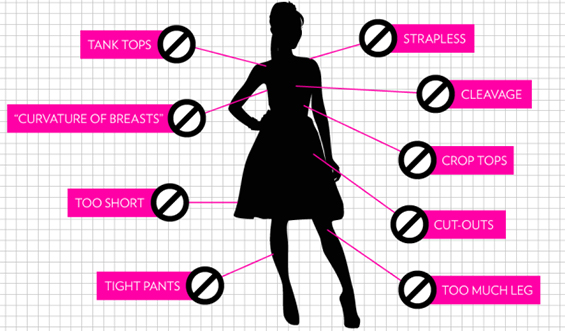An argument against the dress code
Dress codes have been enforced forever, and with new fashion trends coming into style, dress code policies for high schools and middle schools around the country have gotten even stricter over the years.
Many schools have had controversial dress codes for years that tend to favor white male students. Female African-American students are known to receive the most punitive attention when it comes to the dress code policies in many schools across the United States.
These dress codes include, but are not limited to, rules monitoring skirt/short length, how low a neckline can lay, how much of students’ shoulders can show or even “adornments, or decorations in the hair”, which is stated in Mystic Valley Regional Charter School’s “uniform policy” .
MVRCS has had multiple situations where they disciplined a female African-American student for her hair.
Naugatuck High School’s Associate Principal, Ms. Kristina Wallace, has a few words to say about dress codes.
“I do think there is a level of embedded bias or implicit bias in dress codes in terms of often times a dress code for an institution will dictate clothing or headgear that more often or not women or students of color are apt to wear as opposed to male students or white students.”
Regarding our dress code, Ms. Wallace feels that more than half of the rules in our dress code are directed toward students that identify as female.
“When you look generally through most of it, more than half of the list are things that girls would wear,” says Ms. Wallace.
Our dress code includes rules regarding shorts/dress/skirt length, low necklines, “spaghetti straps”, exposed midriff, headbands, and ripped jeans. The school dress code also includes a rule against leggings, which are a staple piece in many female students’ closets.
The dress code at Naugatuck High School does not even take into consideration that people come in all different shapes and sizes. Some girls are curvier than others, and that can cause some disagreement.
For example, a shirt can be seen as inappropriate for a girl that has a larger chest rather than someone that is smaller, even if they are wearing the same shirt.
This could also be a problem with skirts and shorts. Someone whose bottom is bigger than others can run into a problem when it comes to the length of their skirts, dresses, and shorts compared to someone who is skinnier.
Students want to feel comfortable while at school, and when most of the clothing items in their closets violate the dress code, it is hard to have a comfortable and stress-free learning environment.
“It makes a lot of students mad,” says Makenzie Ross, a sophomore at Naugatuck High School.
Many girls feel this way because, especially in the summertime, they cannot wear some of their favorite outfits.
For example, if a girl is violating the dress code in the summer for her shorts, she will be forced to put on a pair of sweatpants provided by the school, or they may have the option to call home to get a change of clothes.
This not only takes time out of the student’s learning time, but this also causes many other problems for the girl.
Making the student put sweatpants on could be more of a distraction than the outfit she was previously wearing. It could make her hot and sweaty all day, causing her to be more focused on how uncomfortable she is rather than spending that valuable time learning.
Another problem that making the student change could cause is self-image issues. Dress code policies, including ours, send the message that girls should cover up because their bodies are distractions.
Social media puts the idea that girls have to look a certain way to meet society’s standards, and being told they have to dress a certain way adds to the stress that teenage girls are already facing outside of their life at school about their bodies.
After surveying about fifty people on an Instagram poll, the final results came out to be twenty-four voted that they feel the dress code at Naugatuck High School is fair and not biased and twenty-three voted that it was not fair.
The people that voted that they felt the dress code was fair was an even mixture of female students and male students. However, the majority that voted that it was not fair were female students with only a few exceptions of male students.
“They favor guys with the dress code,” posted one commenter.
After talking to people about their point of view about the school’s dress code policy, this has come up a lot.
The reason why this has come up goes back to the actual dress code policy and how there is not a lot of things that male students can get dress coded for.
The only thing that revolves mostly around male students is “low slung pants”.
The rest of the dress code is gender neutral with items on the list including:
- any top, pant, short or shirt that exposes undergarments or is see-through;
- clothing which prints vulgarities, promotes illegal activity, displays pictures or words or printed website links that advertise or imply drugs, alcohol or weapons, or displays discriminatory words or gestures;
- coats and all forms of outerwear, including outerwear vests, during the school day;
- scarves, gloves, sunglasses during the school day;
- hats, hoods, headbands during the school day;
- pants or shirts with tears/holes that expose skin;
- chains, belts with ornaments or jewelry that can injure another person;
- any clothing or items worn or displayed that denote gang association are prohibited; including but not limited to beads, bandanas and jewelry; costumes of any kind; even for Halloween.
Another commenter replied, “They don’t really enforce it”.
Both of the commenters were students that identify as female, and their contradicting comments conclude that the dress code policy is not being proportionately enforced by teachers around the school.
Ms. Wallace said that she and the administration want to bring students together so they can work as a team to revise Naugatuck High School’s dress code policy to eliminate any bias that may be in it and to ensure that students are as comfortable as possible in their learning environment.

I am a junior at NHS. I would like to pursue a career in Journalism I enrolled in this class to practice journalistic writing.













